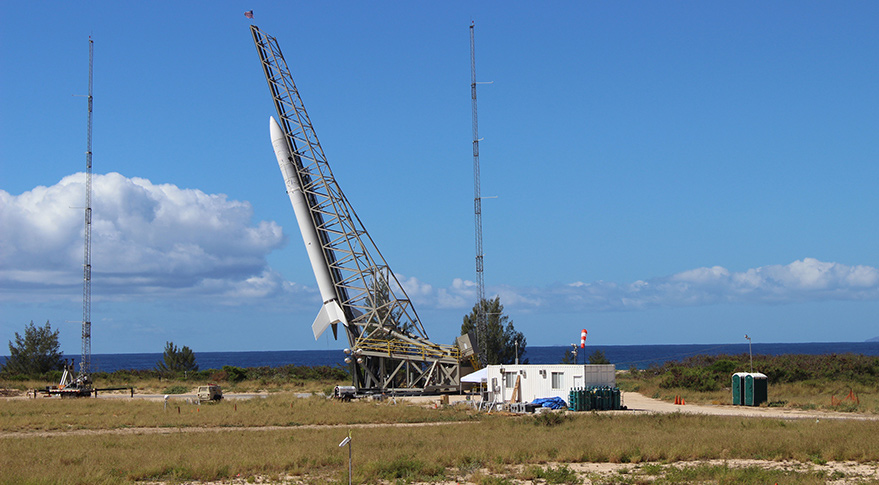Rail-Launched Super Strypi Rocket Packed with Cubesats Fails in Debut

WASHINGTON — An experimental rocket for small satellites took off from Hawaii on its debut mission at about 5:45 p.m. local time Nov. 3, roared toward the sky and then failed less than a minute into flight, the U.S. Air Force said.
The debut of the rail-launched Super Strypi rocket was the key feature of the Operationally Responsive Space (ORS)-4 mission, which carried 13 experimental satellites.
"The ORS-4 mission on an experimental Super Strypi launch vehicle failed in mid-flight after liftoff at 5:45 p.m. Hawaii Standard Time (7:45 p.m. PST/10:45 p.m. EST) today from the Pacific Missile Range Facility off Barking Sands, Kauai, Hawaii," the Air Force said in a brief statement early Nov. 4. "Additional information will be released as it becomes available."
It was not immediately clear from watching the video feed of the launch when the failure occurred, but about a minute into flight, a computer-generated model of the rocket started spinning wildly. The video feed of the launch ended shortly thereafter.
After multiple delays, the fin-guided Super Strypi rocket finally lifted off from the U.S. Navy's Pacific Missile Range Facility in Kauai in the first-ever orbital launch attempt from Hawaii. The range is used for testing of U.S. missile defense systems, among other things.
Air Force leaders, who were hoping to learn about how to accelerate range operations from the launch, had been cautious in discussing the rocket's prospects.
The mission had been originally scheduled for October 2013 but was delayed by technical concerns to November 2014, and then to January 2015. The launch was then set for Oct. 29 but encountered several more delays related to what Air Force officials said were launch processing issues.
Get the Space.com Newsletter
Breaking space news, the latest updates on rocket launches, skywatching events and more!
Col. John Anttonen, then-director of the Air Force's ORS Office, which develops and tests quick-reaction military space capabilities, told SpaceNews in March that the flight would proceed despite a known design flaw in the rocket's first-stage motor.
"We came to the conclusion that yes, we could go fly with this system at a slightly elevated risk," he said. "The important part there was to get with our mission partners — the satellites we're flying — and get them to agree that they're willing to go ahead and take that additional risk.
"For us, the mission is to get the data on the flight. We feel we can do that on this mission all the way up through the first stage. We're pretty confident we'll be able to demonstrate what we're looking for."
Project officials hoped the new launcher, essentially a souped-up sounding rocket, would provide a low-cost launch option for small satellites, including cubesats, which are becoming increasingly popular with universities and government agencies. U.S. defense organizations including the Army, the Air Force and even the National Reconnaissance Office, known for building billion-dollar satellites that launch on heavy-lift rockets, have been investing in cubesats in recent years.
The primary satellite on the ORS-4 mission, known as HiakaSat and developed by the University of Hawaii, would have gathered imagery and monitored the environment during a one-year mission.
The mission carried 12 other cubesats for NASA and several universities as secondary payloads.
Industry officials had said for months that they believed if the mission was a success, the ORS office would have sought funding for additional Super Strypi launches. However, the Air Force told SpaceNews Oct. 22 no other Strypi launches were planned.
The Super Strypi launcher was expected to be able to place as much as 300 kilograms of payload into low-Earth orbit.
Based on designs developed by the U.S. Department of Energy's Sandia National Laboratory in New Mexico as part of nuclear testing programs dating back to the 1960s, the Super Strypi ultimately was expected to cost about $15 million per mission, officials had said.
The three-stage, solid-fueled rocket was assembled in partnership with the University of Hawaii's Space Flight Laboratory and Sandia. Aerojet Rocketdyne provided the rocket motors.
Sandia had been studying how to transition the launch system to the commercial world, which could use a low-cost rocket to replenish constellations of small satellites.
The failure follows on the heels of an Oct. 29 U.S. Government Accountability Office report saying none of several Defense Department efforts to field quick-reaction launch vehicles, including ORS-4, had advanced past the development stage.
This story was provided by SpaceNews, dedicated to covering all aspects of the space industry.
Join our Space Forums to keep talking space on the latest missions, night sky and more! And if you have a news tip, correction or comment, let us know at: community@space.com.
Mike Gruss is a veteran defense reporter and Editor-in-Chief of Sightline Media Group, which includes Army Times, Air Force Times, Dense News, Military Times and Navy Times. From 2013 to 2016, Mike served as a Senior Staff Writer for SpaceNews covering national security space programs and military space policy in the U.S. Congress. Mike earned a bachelor's degree in English and American Studies from Miami University and has previously wrote for the Journal Gazette in Fort Wayne, Indiana and the Virginian-Pilot in Virginia before joining SpaceNews. Prior to joining Sightline in 2017, he was a senior editor of FedTech magazine covering technology in federal government. You can see Mike's latest project on Twitter.

